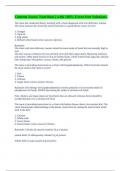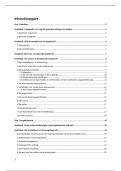Content Areas: Nutrition || with 100% Error-free Solutions.
The nurse has conducted dietary teaching with a client diagnosed with iron deficiency anemia.
The nurse instructs the client that which food item is a good dietary source of iron?
1. Oranges
2. Apricots
3. Egg whites
4. Refined white bread correct answers Apricots.
Rationale:
The client with iron deficiency anemia should increase intake of foods that are naturally high in
iron.
The best sources of dietary iron are red meat, liver and other organ meats, blackstrap molasses,
and oysters. Other good sources of iron are kidney beans, whole-wheat bread, egg yolk, spinach,
kale, turnip tops, beet greens, carrots, raisins, and apricots.
The nurse is providing instructions to a client with hypophosphatemia. Which food item should
the nurse instruct the client to avoid?
1. Fish
2. Cheese
3. Chicken
4. Organ meats correct answers Cheese.
Rationale: Diet therapy for hypophosphatemia consists primarily of an increased intake of
phosphorus-rich foods, WHILE decreasing the intake of calcium-rich foods.
Fish, chicken, and organ meats are food items that are allowed, whereas cheese should be
avoided because it is a calcium-rich food.
The nurse is providing instructions to a client with kidney disease about a low-protein diet. The
client demonstrates understanding of the dietary instructions by stating the need to limit which
food in the diet?
1. Chicken
2. Whole milk
3. Swiss cheese
4. Peanut butter correct answers Chicken
Rationale: Chicken (3 ounces) contains 26 g of protein
peanut butter (2 tablespoons) contains 9 g of protein.
Whole milk (1 cup) contains 8 g of protein
,Swiss cheese (1 ounce) contains 7 g of protein.
The nurse is providing dietary instructions to a client about the food items that are high in
vitamin K. Which food item does the nurse recommend as being highest in vitamin K?
1. Fish
2. Spinach
3. Potatoes
4. Strawberries correct answers Spinach.
Rationale:
Liver and green leafy vegetables such as spinach are high in vitamin K.
Fish contains vitamins A, D, and B12. Potatoes and strawberries are high in vitamin C.
A child with leukemia is complaining of nausea. The nurse suspects that the nausea is related to
the chemotherapy regimen. The nurse, concerned about the child's nutritional status, should offer
which item during this episode of nausea?
1. Cool, clear liquids
2. Low-protein foods
3. Low-calorie foods
4. The child's favorite foods correct answers Cool, clear liquids.
Rationale: When the child is nauseated, offering cool, clear liquids is best because they are
soothing and better tolerated. Supportive nutritional measures should include oral supplements
with high-protein and high-calorie foods. The nurse should not offer favorite foods when the
child is nauseated because foods eaten during times of nausea will be associated with being sick.
The nurse is formulating a plan of care for a client receiving enteral feedings. Which client
problem is the highest priority?
1. Diarrhea
2. Nutrition
3. Aspiration
4. Deficient fluid volume correct answers Aspiration.
Rationale: Any condition in which gastrointestinal motility is slowed or esophageal reflux is
possible places the client at risk for aspiration.
Diarrhea and nutrition may be appropriate problems, but they are not of highest priority.
Deficient fluid volume is not likely to occur in this client.
A nurse is evaluating the effect of dietary counseling on the client with cholecystitis. The nurse
should determine that the client understands the instructions given if the client states that which
food item(s) are acceptable in the diet?
1. Baked fish
, 2. Fried chicken
3. Sauces and gravies
4. Fresh whipped cream correct answers Baked fish.
Rationale: The client with cholecystitis should decrease overall intake of dietary fat.
Foods that should be avoided include sauces and gravies, fatty meats, fried foods, products made
with cream, and heavy desserts.
The correct option is baked fish, which is low in fat.
The nurse is monitoring the nutritional status of the client receiving enteral nutrition. Which
intervention should the nurse implement to determine the effectiveness of the tube feedings?
1. Use a calorie count.
2. Obtain a daily weight.
3. Evaluate intake and output.
4. Monitor serum protein level. correct answers Obtain a daily weight.
Rationale: The most accurate measurement of the effectiveness of nutritional management of the
client is through the use of daily weighing.
These weight checks should be done every day at the same time (preferably early morning), in
the same clothes, and using the same scale.
Options 1, 3, and 4 assist in measuring nutrition and hydration status. However, the effectiveness
of the diet is measured by maintenance of body weight.
The nurse provides instructions to a client with a low magnesium level about the foods that are
high in magnesium. The nurse should tell the client to consume which foods? Select all that
apply.
1. Peas
2. Bacon
3. Oranges
4. Cauliflower
5. Peanut butter
6. Canned white tuna correct answers 1. Peas
4. Cauliflower
5. Peanut butter
6. Canned white tuna
Rationale: The normal magnesium level is 1.3 to 2.1 mEq/L (0.65 to 1.05 mmol/L).
Common food sources of magnesium include avocado, canned white tuna, cauliflower, green
leafy vegetables such as spinach and broccoli, milk, oatmeal, peanut butter, peas, pork, beef,
chicken, potatoes, raisins, and yogurt.
Bacon is high in fat and sodium. Oranges are high in potassium.





